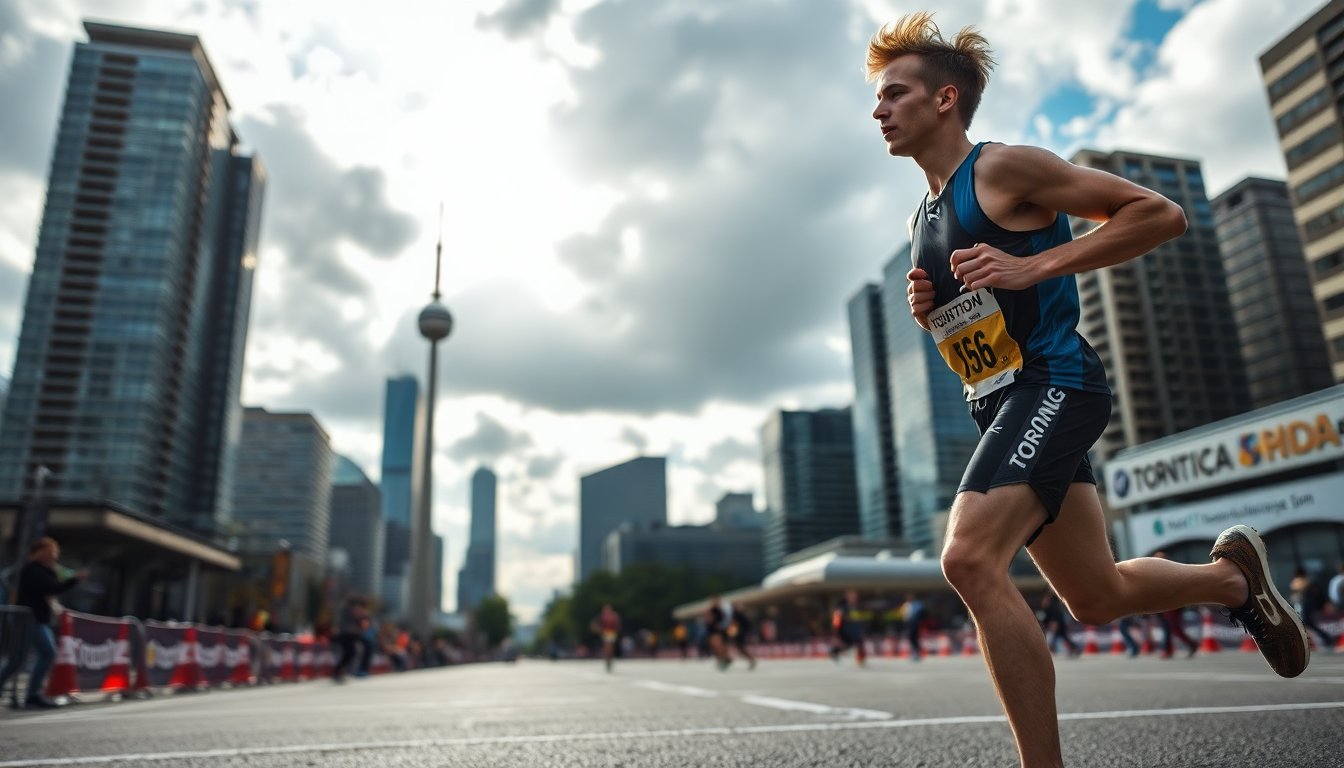Table of Contents
Ben Flanagan has made a significant impact in the marathon scene by winning the Canadian title in his debut race at this distance. Flanagan completed the Toronto Waterfront event in two hours, fifteen minutes, and forty-one seconds, despite challenging weather conditions on a Sunday morning. The heat and wind posed difficulties, yet Flanagan’s determination and skill led him to victory.
Flanagan aims to represent Canada in the 2028 Olympics. He took the lead over Toronto’s Andrew Alexander around the 25-kilometre mark and ran the remaining distance solo.
Race highlights and performance
Flanagan’s performance provided both a victory and valuable experience. Wearing sunglasses, he acknowledged the crowd’s support with a smile as he approached the finish line. He raised both arms in celebration, pausing to catch his breath after finishing. “I’m delighted with my performance, although I felt my body struggling in the last three kilometres,” Flanagan told Canada Running Series. He cited the wind as a significant factor, noting, “With gusts reaching up to 53 km/h, I believe I can improve my time.”
His main objectives were to complete the race, secure the title, and gain insights from his training and the competition. This victory marks a stepping stone for Flanagan, indicating potential for growth as a competitive marathoner.
Competition landscape
In the overall standings, Flanagan finished in 10th place, trailing behind race winner Leonard Langat of Kenya, who completed the marathon in a remarkable time of 2:08:05. Canadian competitors performed strongly, with Phil Parrot-Migas from London, Ontario, finishing as the second Canadian man in 2:17:16, and Andrew Alexander closely following at 2:18:16. Flanagan humorously expressed his nerves about Alexander’s presence, acknowledging the seasoned marathoner’s experience and home advantage.
Flanagan previously described Alexander as “made for marathon,” noting his impressive personal best of 2:12:55 achieved earlier in Houston. This competitive environment fueled Flanagan’s ambition to create distance from his competitors, achieving a decisive lead at the 25-kilometre mark.
Training journey and future aspirations
Flanagan’s training for this marathon included challenges. He faced uncertainty about participation, having struggled to hit the 60-kilometre mark in his training until late July. However, rapid improvements in August bolstered his confidence.
Previously excelling in the 10,000 metres at the University of Michigan and making his Olympic debut in the 5,000 metres last year in Paris, Flanagan has shifted his focus from track racing. He has entered various road races, including five half marathons, with a notable seventh-place finish in New York last March, clocking in at 1:01:31, just 31 seconds shy of his personal best.
Setting the bar for future competitions
Flanagan aims to achieve a marathon time between 2:05 and 2:06 for the 2028 Los Angeles Olympics. He recognizes the current standard set by fellow Canadians, such as Rory Linkletter, whose personal best is 2:06:49, and Cam Levins, who holds the national record at 2:05:36. Flanagan stated, “Right now, Rory is on another level compared to me. I would not be surprised if I eventually reach that level in a couple of years, as Rory is raising the expectations for the Canadian Olympic team.”
Women’s race highlights
In the women’s competition, Rachel Hannah from Port Elgin, Ontario, finished as the top Canadian, completing the race in 2:33:48, significantly ahead of new mother Brittany Moran, who posted a time of 2:42:46. Hannah expressed her joy, stating, “Winning the Canadian championship has been a dream of mine since I started marathoning a decade ago.” This event marked her fastest performance in four attempts at the Toronto Waterfront.
Flanagan aims to represent Canada in the 2028 Olympics. He took the lead over Toronto’s Andrew Alexander around the 25-kilometre mark and ran the remaining distance solo.0
Flanagan aims to represent Canada in the 2028 Olympics. He took the lead over Toronto’s Andrew Alexander around the 25-kilometre mark and ran the remaining distance solo.1


